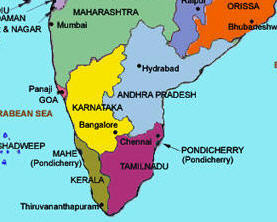
Dravidian Language Family
The Dravidian language family is one of the largest language families in the world. The vast majority of linguists believe that the Dravidian language family is completely unrelated to any other language family. The family includes 73 languages spoken by over 222 million people in southern India, Sri Lanka, certain areas of Pakistan, and in Nepal. Commerce and emigration have also spread Dravidian languages, particularly Tamil, to Burma, Indonesia, Malaysia, Fiji, Madagascar, Mauritius, Guyana, Martinique and Trinidad. The only Dravidian language spoken entirely outside of India is Brahui with over two million speakers mainly in Pakistan and 200,000 speakers in Afghanistan (Ethnologue).

Dravidian languages are mostly spoken in the south of the Indian subcontinent, while Indo-Aryan languages are concentrated in the north. It is thought that Dravidian languages were native to the Indian subcontinent and were originally spread across all of India. The Indo-Aryan languages were introduced by Aryan invaders from the north. They pushed speakers of the original Dravidian languages out of the northern portion into the southern part of India.
Dravidian languages are usually broken up into the following groups, largely based on their geographical distribution. The table below lists only languages with 60,000 or more speakers.
|
Central
|
||
|---|---|---|
| Kolami (Northwestern & Southeastern) | 60,000 | India |
| Duruwa | 75,000 | India |
|
Northern
|
||
| Brahui | 2.2 million | Pakistan, Afghanistan |
| Kurux (Kurukh) | 2 million | India |
| Sauria Paharia (Malto) | 122,000 | India |
|
South Central
|
||
| Maria Dandami | 200,000 | India |
| Gondi Southern | 250,000 | India |
| Gondi Northern | 1.9 million | India |
| Maria | 134,000 | India |
| Pardhan | 117,000 | India |
| Koya | 330,000 to 10 million | India |
| Kui | 717,000 | India |
| Kuvi | 300,000 | India |
| Telugu | 70 million | India |
|
Southern
|
||
| Badaga | 245,000 | India |
| Kannada | 35 million | India |
| Kodagu | 122,000 | India |
| Kurumba | 180,000 | India |
| Malayalam | 35 million | India |
| Tamil | 66 million | India |
| Yerukula | 300,000 | India |
| Tulu | 1.9 million | India |
Status
Tamil, Malayalam, Telugu, and Kannada are four of the 22 official languages and 14 regional languages of India. They are used in administration, education, business, and the media. All four possess a great wealth of written texts. All four have accommodated social, political, technical, and economic changes that occurred in 20th-century India.
Dialects
The dialects of Dravidian languages have evolved along several dimensions:
- geographic.e.g., Malayalam has 10 distinct regional varieties
- religious, e.g., there may be differences in the speech of Christians, Hindus, and Muslims within a single geographic area
- caste-based, e.g., among the Hindus, the speech of members of the highest caste differs from that of members of a medium-high caste, and these, in turn, differ from the speech of members of the low caste
- diglossic, e.g., the speech of the educated elite may be characterized by a greater degree of code-switching between the indigenous language and English
- formal vs. informal, e..g, the formal style is used in most writing as well as in radio and TV programs, and in public speaking, whereas the informal style is used for daily spoken communication
Structure
Sound system
Despite some differences, the sound systems of Dravidian languages share some common features.
Vowels
Most Dravidian languages have five or more vowels that can be either long or short. Vowel length makes a difference in the meaning of otherwise identical words.
Consonants
The consonant systems of Dravidian languages generally share these features:
- contrast between aspirated vs. unaspirated stops and affricates, e.g.,/ p—pʰ, t—tʰ, k—kʰ, b—bʰ, d—dʰ, g—gʰ/. Aspirated consonants are produced with a strong puff of air that accompanies their release.
- contrast between and apical vs. retroflex consonants, e.g.,/ t—ʈ, d—ɖ, n—ɳ, l—ɭ/. Apical consonants are produced with the tip of the tongue touching the roof of the mouth, whereas retroflex consonants are produced with the tongue curled, so that its underside comes in contact with the roof of the mouth.
- variety of nasal consonants.
- restricted number of consonant clusters which occur mostly in initial and medial position
Stress
Stress in Dravidian languages usually falls on the first syllable.
Grammar
All Dravidian languages are agglutinative, i.e., i.e., grammatical relations are indicated by the addition of suffixes to stems. These are strung together one after another, resulting on occasion in very long words. Like all agglutinative languages, Dravidian languages use postpositions rather than prepositions to mark grammatical relations.
Nouns
- There are two numbers: singular and plural. Plural is marked by a suffixes.
- The number of cases varies from language to language.
- There are no articles.
- Some Dravidian languages have three genders: masculine, feminine and neuter. In other languages, nouns belong to two classes: rational and irrational; rational nouns include humans and deities (women may be rational or irrational, depending on the language/dialect); irrational nouns include animals, objects, and everthing else. These classifications are not absolute.
- Personal pronouns are marked for person, case and number. Gender is marked only in the third person singular.
- 1st person plural can be inclusive, i.e., include both speaker and addressee, or exclusive, i.e., exclude the addressee.
- 3rd person plural pronoun is used as a respectful form of address
- Demonstrative pronouns are differentiated by considerations of proximity/remoteness as well as by levels of respect towards the referent.
- Adjectives are not inflected for number, gender, or case.
Verbs
Dravidian verbs are inflected for tense, mood, voice, causativity, and attitude. The basic word order is Subject-Object-Verb.
Verbs
Telugu verbs consist of a root followed by suffixes expressing tense, mood, negation, causativity, person, number, and gender which follow each other in a prescribed sequence. In most Dravidian languages, verbs agree with their subjects in gender, number and person. Subject pronouns are normally dropped since the information about the subject is carried by the verb itself. Dravidian verbs have the following distinguishing features of verbs in most Dravidian languages. Not all languages have all of these features:
- two numbers: singular and plural
- three genders: masculine, feminine, neuter
- three persons: 1st, 2nd, 3rd
- two voices which are not equivalent to the active-passive or reflexive-nonreflexive division of voices in Indo-European languages
- three simple tenses (present, past, and future) marked by simple suffixes, and a series of compound tenses marked by auxiliary verbs
- a special verb paradigm in which a negative-tense marker is suffixed to the verb stem forming a negative tense
- four moods which indicate whether the action of the verb is unreal, possible, potential, or real
- transitivity and intransitivity
- attitude expressed by auxiliary verbs to show the speaker’s feelings towards an event expressed by the verb, e.g., pejorative opinion, antipathy, relief, etc.
Word order
The standard word order in Dravidian languages is Subject-Object-Verb. However, other orders are possible because Inflectional endings take care of keeping clear grammatical relations and roles in the sentence. There are special markers for topic (what the sentence is about, or old information) and focus (new information). Constituents with old information precede constituents with new information, or those that carry most emphasis. Modifiers usually precede the words they modify.
Vocabulary
The most important sources of early loanwords in Dravidian languages have been Sanskrit, Pali, and Prakrit. Different Dravidian languages borrowed words from neighboring Indo-Aryan languages spoken in India to differing degrees. For instance, Tamil has the lowest number of Indo-Aryan loanwords, while in Malayalam and Telugu the percentage of loanwords is substantially higher. In modern times, Dravidian language borrowed from Urdu, Portuguese, and English. In Tamil, there is currently a movement to remove as many borrowings from Sanskrit as possible. All four major Dravidian languages (Tamil, Telugu,Kannada, Malayalam) have succeeded in developing new technical terms, using English, Sanskrit, and indigenous models. Modern Dravidian languages use compounding and reduplication to form new words. In addition, there are numerous onomatopoeic words.
Below are numerals 1-10 in four major Dravidian languages in romanization.
|
1
|
2
|
3
|
4
|
5
|
6
|
7
|
8
|
9
|
10
|
|
|---|---|---|---|---|---|---|---|---|---|---|
| Kannada |
ondu
|
eraɖu
|
muuru
|
naa(lak)ku
|
aydu
|
aaru
|
eeɭu
|
eɳʈu
|
ombhattu
|
hattu
|
| Malayalam |
onnu
|
randu
|
munnu
|
nallu
|
anch
|
aaru
|
ezhu
|
ettu
|
empathu
|
pattu
|
| Tamil |
oṉṟu
|
iraṇṭu
|
mūṉṟu
|
nāṉku
|
ainthu
|
āṟu
|
ēḻu
|
eṭṭu
|
oṉpathu
|
paththu
|
| Telugu |
okați
|
rendhu
|
múdhu
|
nálugu
|
aidhu
|
áru
|
yédhu
|
yenimidi
|
tommidhi
|
padhi
|
Writing
Dravidian languages are written with syllabic alphabets in which all consonants have an inherent vowel. Diacritics, above, below, before or after consonants indicate change to a different vowel or suppression of the inherent vowel. When they appear the the beginning of a syllable, vowels are written as independent letters. When certain consonants occur together, special conjunct symbols are used which combine the parts of each letter.
Below are the names of four languages written in their native scripts.
| Tamil | |
| Telugu | |
| Kannada | |
| Malayalam |
Difficulty
 How difficult is it to learn Dravidian languages?
How difficult is it to learn Dravidian languages?Since these languages are not taught at the Foreign Service Institute, they are not categorized for difficulty..